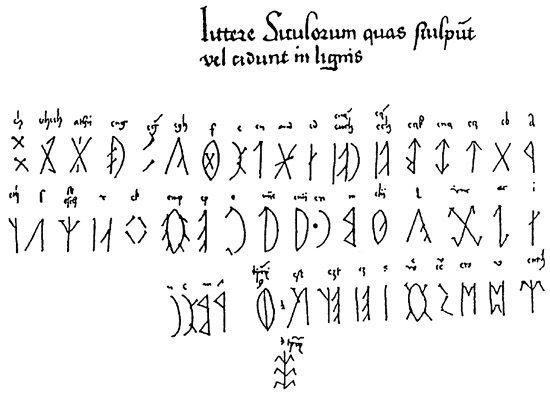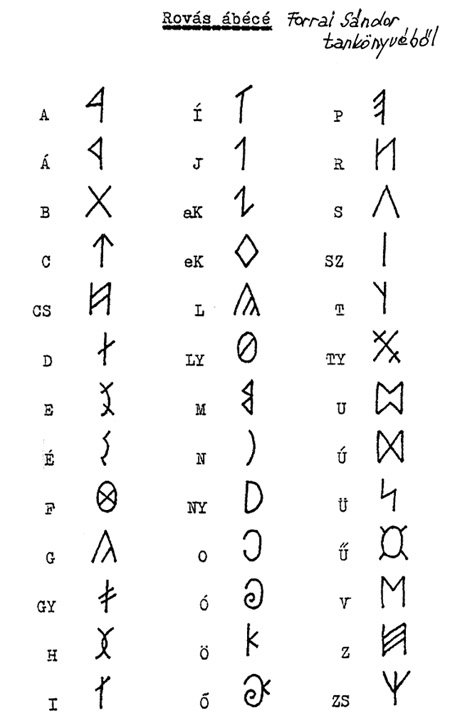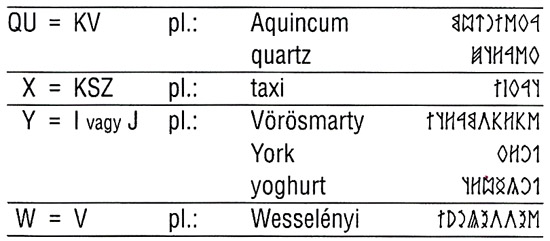|
|
|
About the ancient Hungarian writing
|
|
|
Klára
Friedrich: |
What is
the ancient Hungarian writing?
The name of
this writing in Hungarian and international bibliography is different, for example:
ancient Hungarian runic writing, Hungarian carved writing, Hungarian
'rovás' writing, ancient 'Magyar rovás', Escil runic script,
Sekler-Hungarian runic script, Sekler graved writing, Hungarian
incised script. In the international writing system standard-Unicode: Old
Hungarian. In the following text: ancient Hungarian writing.
This is a characterestic,
mostly linear ancient script and one letter stands for one sound. These letters
can be used on any surface: stone, wood, metal, parchment, paper, silk, etc.
The Hungarian
word for this writing 'rovásirás' is the main term. The word 'rovás'
refers to incised, cut out or engraved writings when the letters are impressed
in the surface. The computerized form of ancient writing, too, belongs to the
main term 'rovásirás".
We know other
runic relics from other peoples too; we refer to Pelasgic, Phoenician, Etruscan,
Latin, Greek, Germanic and Turkic writings. However, I conclude in accordance
with my script-historic research that all these ancient writings evolved from
the ancient Hungarian one.
The word run (runa) derives from the root *rün-. In Hungarian ró (root) and róni (infinitive) meaning to incise, engrave is the basic for the word 'rovás'. It is interesting to know that in Lithuanian ruoti means both to cut with a knife and to speak... (M.T.)
The ancient Hungarian writing
derives from our Scythian, Hun and Avar forefathers. Due to archaeological and
other object relics we can say that this is the first writing on Earth in which
one letter matches one sound.
Therefore, this writing
is a much appreciated culture-historic treasure of Hungarians, the noblest form
of loyalty to our traditions. Our chroniclers and historiographers often refer
to this script: Simon KÉZAI, Márk KÁLTI, János THURÓCZY, Antonio BONFINI, Antal
VERANCSICS, István SZAMOSKÖZI, Mátyás BÉL called it Scythian-Hun writing. The
term 'rovásirás' is due to Mihály TAR, who had learned it early 20th century
from his shepherd ancestors, and János FADRUSZ, sculptor of the most famous
equestrian statue of king Matthias standing in Kolozsvár (today Cluj in Romania).
The name is an excellent expression referring to the characteristics of the
way of writing: it can be carved in wood, engraved in stone, written on paper.
It is also referred to as Sekler-Hungarian writing because the most written
relics are kept among the Seklers in Transylvania. Thanks to the Hungarian scout
movement, it remained alive after 1945.
Our ancient writing has
developed together with our language, evidenced by the fact that each sound
of the Hungarian language can be recorded by one letter. That is why we can
state that this is our own script and was not borrowed from any other writing
system. It is an alphabetic writing, so even abstract terms can be written down.
When in the 11th-12th century Latin script had been introduced in Hungary, literate
society was confronted with the fact that 13 Hungarian sounds were lacking their
adequate letters (TY, GY, NY, LY, SZ, ZS, CS, K, J, Á, É, Ö, Ü). It was thus
impossible to write down Hungarian language correctly.
Ancient Hungarian writing
relics attest the fact that Hungarians are indigenous inhabitants in the Carpathian
basin. We have a 15-20 000 years old bone stick from a cave near village Bajót,
a 7-8000 years old clay disc with inscription from Tatárlaka and a collection
of clay discs with inscriptions dating from new stone-age, picked up by Zsófia
Torma (1832-1899), the lady archaeologist from Transylvania. The two last mentioned
groups of relics belong to the Tordos-Vinca culture blooming 5500-3000 BC. The
shape of the signs engraved in clay is similar to the Hungarian runic letters.
The ancient Hungarian writing is a further evidence of the Scythian-Hun-Avar-Hungarian continuity because it is present on archaeological relics and artefacts of all these peoples. Let us mention the 2700 years old Scythian silver cup, the Hunnic rock inscription in Russia, the inscription on the Avarian needle case from Szarvas, the calendar staff from the time of the Arpad dynasty. The Greek Agathon mentions the writing of our Sycthian-Hunnic ancestors in the 3rd century BC, similarly to the Syrian-Greek traveller Lucianos in the 2nd century AD, or the Greek scientist Priscos who visited the king of the Huns Attila in the 5th century.
The ancient Hungarian writing
is a further evidence for the literacy of the population in a time when the
emperor Charlemagne was not able to read and write according to his biographer
Einhard. This was exactly the period when the bone needle case was provided
with writing, as it was found in the grave of a woman near today's town of Szarvas.
60 letters are engraved on the surface of the needle case. This writing was
in use by shepherds in Hungary as late as the 19th-20th century. In 1802 a message
consisting of 160 words was engraved on 16 staffs in Kiskunhalas - and the notary
of the town was able to read it.
This writing challenges
the claim that Hungarians have learned to read and write from the clergymen
imported from Western Europe in the 11th century, as well as the theory of Finno-Ugric
origin of the Hungarians and the affinity of their languages.
Well known
artifacts with ancient Hungarian inscriptions
The bone needle case from
the time of the Avars found near Szarvas is exhibited in the Museum Sámuel Tessedik
in Szarvas.
The baptismal font from
the 13th century in Vargyas, (Seklerland, Transylvania) stands in the reformed
church designed by Imre Makovecz.
The copy of a staff calendar from the 12th-13th century from Gyergyószárhegy (Seklerland, Transylvania) displays an inscription of almost 200 words. The Italian scientist and military engineer Luigi Ferdinando Marsigli copied it in 1690; the object is kept in a library in Bologna. Picture 1.

Picture 1.
The so called alphabet from Nicholsburg was written down before 1483; it is kept today in the National Library Széchényi in Budapest. Picture 2.

Picture 2.
A beautifully painted inscription
on the coffered ceiling in the Unitarian church in Énlaka (Seklerland, Transylvania)
was made in 1668. We may have a look at it as long as the woodworm does not
eat it up.
A teaching book was written
in 1598 with the title: Rudimenta, or elements of the ancient language of
the Huns. Author was János Thelegdi, later on a catholic clergyman, bishop
of Nyitra and archbishop of Kalocsa. The book consists of 16 pages. He wrote
it when he was 24 years old during his study time in Leiden. Only copies in
manuscript have been preserved.
The majority of the oldest
authentic ancient Hungarian alphabets consist of 32 letters, however without
long vowels. The letter É is already present in a text from 1654 written by
Gáspár Miskolczi Csulyak, but this letter did not spread generally. (He was
the son of István Miskolczi Csulyak, military priest of Prince Gábor Bethlen.
He studied in Wittenberg and Heidelberg.) The introduction into general use
of the letters Á and É is due to the ethnography researcher and ornamental artist
Adorján Magyar (1887-1978); and so the alphabet had 34 letters.
The researcher Sándor Forrai, teacher of steno and dactylography used to teach our old writing in the school. He wanted to spare his students from a conflict with the academic spelling; therefore he started to look in old, authentic inscriptions for suitable signs to be used for the missing long vowels and completed the alphabet to a total of 39 letters. Picture 3.

Picture 3.
Based on my experiences in teaching I recommend starting teaching runic writing after the 3rd school year when the pupils have a stable basic knowledge in spelling. There is no age limit; many adults have learned rovás in grandparent age ... An example is the mother of our swimming world champion, Krisztina Egerszegi: she transcribed Sándor Petőfi's poem János vitéz (The Hero János), in ancient hungarian script.
Gábor Szakács, writer and journalist, who organized between 1997 and 2011 different
events and contests in the subject, contributed a lot to the spreading and popularizing
of the ancient Hungarian writing. He approached all the teachers and students
of rovás in the Carpathian Basin and even scouts from Stuttgart entered the
competition. Thanks to all these efforts and to the work in circles, ancient
Hungarian writing has been introduced in 2013 in the teaching program as part
of the subject regional and cultural studies.
János Baranyai Decsi, teacher
of the reformed higher school in Marosvásárhely in the 16th century wrote about
the ancient Hungarian writing:
"... Anybody is able to learn these letters easily in the shortest time.
Therefore, I consider these letters not only worth of being taught in every
school and to every child, but also estimable for the purpose that all our people,
children, elderly, women, nobles and peasants, briefly, all those who want to
be called Hungarian, learn this writing."
The most
important rules of the ancient Hungarian writing
Summary by Klára Friedrich
1. The ancient Hungarian
writing has to be written from right to left; this is the way how most old writings
were written. It is possible also to write from left to right, however, this
way does not meet the tradition. In this case the letters must be also turned
facing from left to right. The most ancient writings were written from right
to left, such as the Pelasgic, the Etruscan, the Greek and the Latin but even
the Egyptian hieratic writing.
2. Today we separate
the words by space. The first letter of a sentence and of a name is emphasized
by a bigger size. Punctuation marks are the same as in the Latin script but
question mark, comma, quotation mark have to be inverted.
3. In ancient Hungarian
script two kinds of K are in use: one is a hoop shaped sign, the other
is a square shape. The rules for their use in the 20th century are not confirmed
in old scripts according to my research, therefore I suggest that beginners
use only the square shaped K. This form is identical with old, authentic
runic relics. In olden times, not only the consonants: (e)F, (e)L, (e)M, (e)N,
(e)NY, (e)R, (e)S, (e)SZ were pronounced with a preceding e, but every consonant.
Thus: (e)B, (e)C, (e)CS... ...(e)K, and this K was written with
the square shape.
4. It is an important
rule that today we use in this script only those letter forms, which can be
identified in a text written before the 18th century. We can keep the authenticity
only when following this rule.
5. In our ancient writing there was no Q, X, Y, W, because these are not in the Hungarian system of sounds. Their use is shown in the attached chart. Picture 4.

Picture 4.
References:
Thelegdi
János "Rudimenta, Priscae hunnorum linguae..." azaz a hunok régi
nyelvének elemei... (1598, Ars Libri kiadó, 1994)
Csallány Dezső: A székely-magyar rovásírás emlékei (A Nyíregyházi Jósa
András Múzeum évkönyve, III. 1963)
Csallány Dezső: A magyar és az avar rovásírás (A Nyíregyházi Jósa András
Múzeum évkönyve, 1969, XI.)
Csallány Dezső: Rovásírásos emlékek a Kárpát-medencében (A Nyíregyházi
Jósa András Múzeum évkönyve, XII-XIV.1972)
Faulmann, Karl: Illustrierte Geschichte der Schrift (Wien, 1880)
Fehérné Walter Anna: Az ékírástól a rovásírásig, I-II. kötet (1975)
Ferenczi Géza: Székely rovásírásos emlékek (Székelyudvarhely, 1997)
Fischer Károly Antal: A hún-magyar írás és annak fennmaradt emlékei (1889,
Hun-idea Kiadó, 2005)
Forrai Sándor: Az ősi magyar rovásírás az ókortól napjainkig (Antológia
Kiadó, 1994)
Forrai Sándor: A magyar rovásírás elsajátítása (1996)
Friedrich, Johannes: Geschichte der Schrift (Heidelberg, 1966)
Friedrich Klára: Rovásírás tankönyv és szakköri ötlettár (2003- 2011)
Friedrich Klára-Szakács Gábor: Kőbe vésték, fába rótták (2005)
Friedrich Klára-Szakács Gábor: Ősök és írások (2008)
Friedrich Klára: Írástörténeti áttekintő magyar szempontból (2010)
Friedrich Klára: Megfejtések könyve (2013)
Friedrich Klára: Felvidéki rovásemlékek (2014)
Gimbutas, Marija: The gods and goddesses of the old Europe (1974)
Gimbutas, Marija: The Living Goddesses (University of California Press,
1999)
Gimbutas, Marija: The language of the Goddess (Thames and Hudson, 2001)
Jakubovich Emil: A székely írás legrégibb ábécéi (Budapest, 1935)
Magyar Adorján: Ős magyar rovásírás (U.S.A., Warren, 1970)
Németh Gyula: A magyar rovásírás (Magyar Nyelvtudományi Közlöny, 1934)
Makkay János: A tartariai leletek (Akadémiai Kiadó, 1990)
Mandics György: Róvott múltunk (Irodalmi Jelen Kiadó, I-III, 2010-2011)
Németh Gyula: A magyar rovásírás (Magyar Nyelvtudományi Közlöny, 1934)
Roska Márton: A Torma Zsófia gyűjtemény (Kolozsvár, 1941)
Sebestyén Gyula: Rovás és rovásírás (1909, Tinta Kiadó, 2002)
Sebestyén Gyula: A magyar rovásírás hiteles emlékei (1915)
Szakács Gábor: A kortárs rovásírás atyja (Beszélgetés Forrai Sándorral,
Magyar Demokrata, 2003/7)
Szakács Gábor: Az EMP jel titka (Magyar Demokrata, 2007/8)
Szakács Gábor: Marsigli, Magyarország fölfedezője Magyar Demokrata, 2008/46.)
Szakács Gábor: Marsigli nyomdokain (Magyar Demokrata, 2011/6)
The Danube script in light of the Turdas and Tartaria discoveries
(Exhibition catalogue, National History Museum of Transylvania, 2009)
Winn, Shan, M.M: Pre writing in south-eastern Europe (Western Publishers,
1981)
|
|
|
About the ancient Hungarian writing
|
|
|